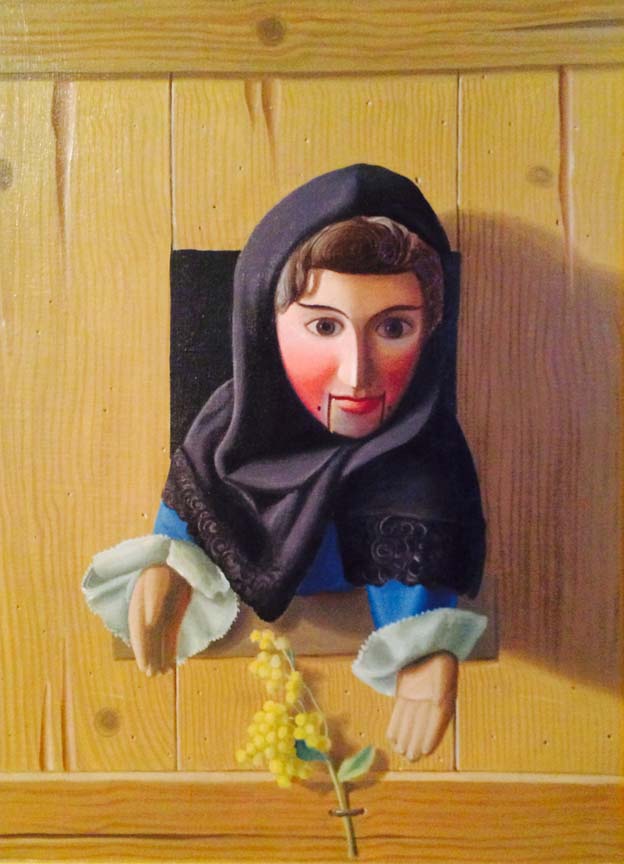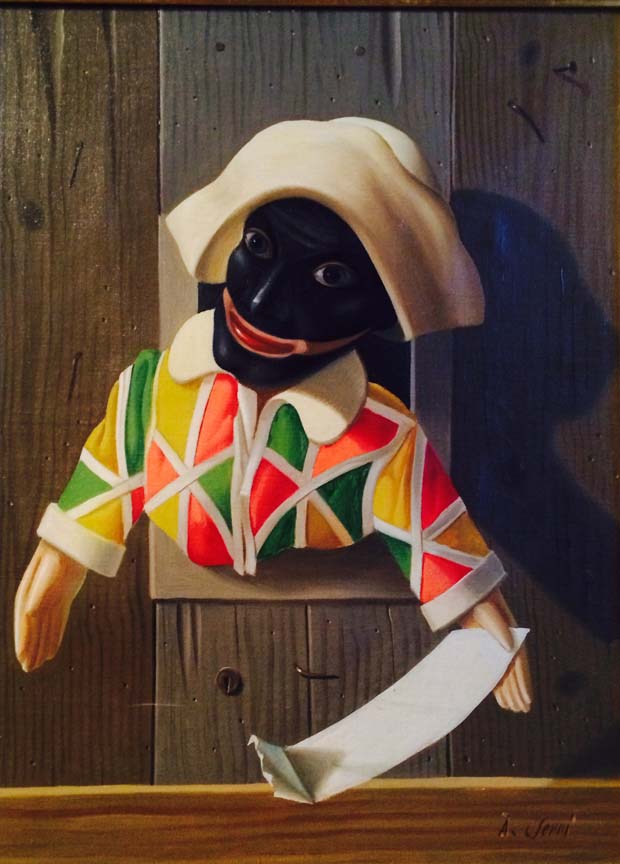



ALFREDO SERRI
"PUPPETS"
OILS ON CANVAS, SIGNED
ITALY, C.1950
15.75 X 12 INCHES EACH
Alfredo Serri 1898-1972 In the first retrospective dedicated to Alfredo Serri (1898-1972), the Tuscan art genuine interpreter of the twentieth century and also wants to be a proper recognition to an artist cultured and sensitive, but soon led to public relations. The exhibition 'Alfredo Serri. The universe comes together in silence ', edited by Stefano De Rosa, is open from today, October 24 to January 18 at Spazio shows of' Ente Cassa di Risparmio di Firenze, and collects a hundred works coming mostly from the Gallery Open Art Prato who worked on the event sponsored and organized by Ente Cassa. At this important group we have added other masters near Serri and who have shared a part of the activity such as Pietro Annigoni, Gregory Sciltian, Antonio and Xavier Bueno, Giovanni and Carlo Acci Guarienti, coming from the Uffizi Gallery, the Foundation Studies of Art History Roberto Longhi and private collectors, which help to better understand the artistic development of the first student of Annigoni. In presenting this morning to the press together with the curator and the Vice President Ente Cassa Director General Renato Gordini Ente Cassa Pierluigi Rossi Ferrini, he stressed '' the success, well above expectations, which has been the opening of the Exhibition Area '' located on the ground floor of the headquarters of the Foundation. '' We thought about these environments, two years ago - he added - with the dual purpose of promoting the works of our art collection (about 11,000 pieces) and to enhance the best of Florentine artistic production, perhaps best known in the world and in our home. Today we can say with some satisfaction to have won this challenge ''. Before devoting himself to painting, Serri was a musician: it was in fact a professor of guitar, violin and piano and, as a violinist, made the Orchestra of the Teatro della Pergola in Florence. However, he gave up a safe place and already acquired in music to devote himself entirely to painting. A choice emerged from the meeting with Pietro Annigoni (1910-1988) with whom he had developed a sincere friendship, though Serri had 11 years older than him. Serri attended assiduously studying Annigoni in Piazza Santa Croce and shared with him his first artistic adventures, studying nature with a specific inclination towards Italian and Flemish seventeenth-century painting, obviously careful all the visual excitement that his city, Florence, he could offer. Along with teacher and mentor, to Gregory Sciltian, the brothers Antonio and Xavier Bueno, John and Charles Acci Guarienti, Serri took part in the movement of 'The Modern Painters of Reality' that, between 1947 and 1949, with exhibitions and through the 'Art' magazine published in Florence, he placed himself in direct conflict with the various abstractionist and informal current fate in those years. The group argued, in fact, a type of painting that aspired to a dialectical balance between the figurative art established in historical time and surfaced linguistic innovations in the twentieth century. Subsequently, while the other motion friends went their separate ways, Serri, as Annigoni, remained consistent with the original address, but instead of the Master, which does not often fail to take explicit position and polemic against his detractors and trends prevailing current criticism, he continued his research in the silence, in isolation, in a sort of intellectual and moral purity. This is an attitude, which is guaranteed to penalize in terms of visibility and a more extensive and widespread fame, even if he had, for the quality of his painting, its own audience of collectors especially in the US context. For this reason, after the great exhibition of Annigoni, who has also had much success outside of Italy and which was sponsored and organized by the Ente Cassa di Risparmio di Firenze last year, it seemed appropriate to start from Serri a 'visual journey 'through some of his most important students and representative, especially since its Serri, unlike the Sciltian caliber personalities, the Bueno brothers and the same Annigoni, required a significant critical and historical preservation, in order to make him known and appreciate to a wider audience. In what was the fundamental contribution of the Open Art Gallery of Prato and Dr. Mauro Stefanini who has provided the exhibition and its catalog most of the exhibits. As for the content Serri had predilection for two kinds congenial to him such as the trompe-L'oeil and still life compositions with books, fruits, various objects and quotes picked artwork. In his splendid still lifes often it emerges in a few millimeters of the pictorial surface, among flasks and fruit, his self-portrait solved with astonishing technique. Often, also they appear instruments and musical scores, clear testimony of his early training and professional activities. Serri produced works of an absolute perfection, in which everything appears as a kind of high hymn to beauty, to poetry, to the secrets and harmonic arrangements that combine the man and the artist to the universe, and make him a messenger of splendors ever ephemeral. His works are now exhibited in numerous Italian and foreign collections, public and private, including the Gallery of Modern Art and the Roberto Longhi Foundation in Florence, the Civic Museums of Milan, the Guelpa Ivrea Foundation and New York's Rockefeller Collection . The exhibition is accompanied by a catalog published by Polistampa with lyrics by Emmanuel Barletti and Stefano De Rosa. |